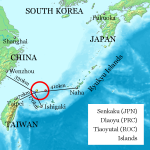China and Japan Hold Talks To Resolve Maritime Disputes
 On January 13th, 2015, China and Japan held another round of maritime crisis management talks in Tokyo, primarily aimed at establishing a mechanism that could defuse tensions in the East China Sea. Representatives from both Defense Ministries discussed technical issues regarding the mechanism’s implementation, and agreed to accelerate its launch. The additional round of talks shows signs that both countries are trying to place their pragmatic interests ahead of their ideological differences. However, the talks did not include any measures to resolve the ongoing dispute over the Senkaku/Diaoyu Islands, implying that there could continue to be tensions between the two countries and in the region as a whole.
On January 13th, 2015, China and Japan held another round of maritime crisis management talks in Tokyo, primarily aimed at establishing a mechanism that could defuse tensions in the East China Sea. Representatives from both Defense Ministries discussed technical issues regarding the mechanism’s implementation, and agreed to accelerate its launch. The additional round of talks shows signs that both countries are trying to place their pragmatic interests ahead of their ideological differences. However, the talks did not include any measures to resolve the ongoing dispute over the Senkaku/Diaoyu Islands, implying that there could continue to be tensions between the two countries and in the region as a whole.
This is the fourth round of negotiations regarding the establishment of a consultative mechanism that began in 2012, but were halted in September 2012 after flare ups in the disputed Diaoyu/Senkaku Islands. According to The Diplomat, this consultative mechanism was meant to establish a method for Chinese and Japanese leaders to quickly communicate in the event of a diplomatic emergency in the East China Sea. Measures would include connecting a hotline between the two leaders, regular meetings among senior officials from both countries, and direct communication between sea-faring vessels in close quarters. Policymakers hope that the mechanism will launch by the end of 2015, and contribute to reducing tensions in the region. At the most recent China-Japan meeting in November, both Xi and Abe reaffirmed that they would begin taking steps towards reconciliation. With the recent initiation of a fourth round of talks, it appears the meeting in November provided the catalyst for in-depth and detailed talks
In addition, these negotiations to tamp down tensions demonstrate both countries’ pragmatism in lowering tensions in an increasingly volatile region. in 2014, Japan’s investment in China fell by 38 percent to a low of USD $4.3 billion. The decline may be signs of a slowing Chinese economy as China has seen a reduction in Foreign Direct Investment, which experts in the region have attributed to the souring of relations between China and Japan. Japan has also been dealing with its own economic problems. Recently, Prime Minister Abe held an election in December to restore a “mandate” for additional economic reforms. Japan also continues to suffer from slow growth and a high debt to GDP ratio. By holding these maritime talks and trying to repair relations, both countries have taken a solid step in continuing and strengthening their economic ties.
China’s pragmatic approach to Japan also builds on its previous actions with other Asian regional partners. Last fall, China signed a maritime agreement with Vietnam to decrease tensions in the South China Sea. The prospect of another peace maritime agreement with an Asian country may mean that China may be seeking more peaceful resolutions to conflicts. Although it has been incredibly difficult to gauge the intentions of the Chinese government, these maritime agreements point towards a stronger likelihood of peace and stability in the Asia-Pacific Region.
However, there remain signs that the movements toward peace may not last. Many domestic newspapers in China continued to lampoon Japan for being the primary aggressor in the region. Commentary in Xinhua, one of China’s largest newspapers, accused Japan of taking a “hardline” stance by “nationalizing” the Senkaku/Diaoyu Islands. These proactive tactics, according to Xinhua, was one of the reasons why tensions were so high in the first place. There was also a growing spat online about who truly owned the disputed islands. Both China and Japan launched websites exposing their own views and why they believed they had ultimate claim over the islands. These factors point to the fact that the maritime dispute may be far from resolved.
In fact, in the exact language of the most recent talks between China and Japan, there was a Herculean effort in trying to tiptoe around the issue of the maritime dispute. Since Japan continues not to recognize the very existence of a dispute, there may be future problems. Although these recent agreements will no doubt help reduce tensions in the region, China and Japan will still need to continue to make solid strides in resolving the Senkaku/Diaoyu Island dispute. The current round of talks represent a good start, but without progress in future negotiations, the possibility of conflict will continue to be high.
